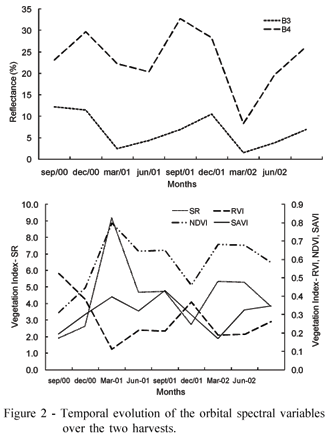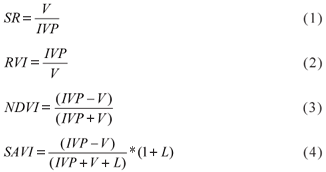Temporal analysis of crop development in commercial fields requires tools for large area monitoring, such as remote sensing. This paper describes the temporal evolution of sugar cane biophysical parameters such as total biomass (BMT), yield (TSS), leaf area index (LAI), and number of plants per linear meter (NPM) correlated to Landsat data. During the 2000 and 2001 cropping seasons, a commercial sugarcane field in Araras, São Paulo state, Brazil, planted with the SP80-1842 sugarcane variety in the 4th and 5th cuts, was monitored using nine Landsat images. Spectral data were correlated with agronomic data, obtained simultaneously to the imagery acquisition. Two methodologies were used to collect spectral data from the images: four pixels (2 × 2) window and average of total pixels in the field. Linear and multiple regression analysis was used to study the spectral behavior of the plants and to correlate with agronomic variables (days after harvest-DAC, LAI, NPM, BMT and TSS). No difference was observed between the methodologies to collect spectral data. The best models to describe the spectral crop development in relation to DAC were the quadratic and cubic models. Ratio vegetation index and normalized difference vegetation index demonstrated correlation with DAC, band 3 (B3) was correlated with LAI, and NDVI was well correlated with TSS and BMT. The best fit curves to estimate TSS and BMT presented r² between 0.68 and 0.97, suggesting good potential in using orbital spectral data to monitor sugarcane fields.
biomass; leaf area index; crop development analysis; spectral behavior









